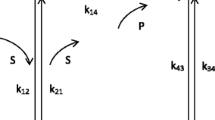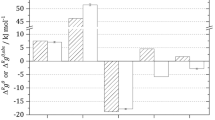Abstract
The mainstream explanation of enzyme catalysis relies on the assumption that enzymes can utilize the binding energy. The author suggest that (i) an enzyme with excess free energy first gives a group from its active site into the final place of the bound reactant (substrate) in order to break the first initial chemical bond; (ii) this enzyme accepts a similar group from the second bound reactant (or second group in the case of the single-substrate) into active site and finish the substrate conversion and enzyme regeneration. The detailed mechanisms of the well-studied reactions of peptide bond hydrolysis catalyzed by α-chymotrypsin and the glyceraldehyde-3-phosphate interconversion steps in glycolysis are in accordance with the proposed theoretical conclusions.
Similar content being viewed by others
References
Fischer E (1894) Einfluss der configuration auf die wirkung der enzyme. Ber Dtsch Chem Ges 27:2985–2993. doi:10.1002/cber.18940270364
Haldane JBS (1930) Enzymes. Green and Co, London
Koshland DE, Neet KE (1968) The catalytic and regulatory properties of enzymes. Annu Rev Biochem 37:359–410
Wolfenden R, Snider MJ (2001) The depth of chemical time and the power of enzymes as catalysts. Acc Chem Res 34:938–945
Wolfenden R (2003) Thermodynamic and extrathermodynamic requirements of enzyme catalysis. Biophys Chem 105:559–572
Fogel AG (1982) Cooperativity of enzymatic reactions and molecular aspects of energy transduction. Mol Cell Biochem 47:59–64
Hengge AC, Stein RL (2004) Role of protein conformational mobility in enzyme catalysis: acylation of alpha-chymotrypsin by specific peptide substrates. Biochemistry 43:742–747
Davenport RC, Bash PA, Seaton BA, Karplus M, Petsko GA, Ringe D (1991) Structure of the triosephosphate isomerase-phosphoglucolohydroxamate complex: an analogue of the intermediate on the reaction pathway. Biochemistry 30:5821–5826
Bash PA, Field MJ, Davenport RC, Petsko GA, Ringe D, Karplus M (1991) Computer simulation and analysis of the reaction pathway of triosephosphate isomerase. Biochemistry 30:5826–5832
Jedrzejas MJ (2000) Structure, function, and evolution of phosphoglycerate mutases: comparison with fructose-2,6-bisphosphatase, acid phosphatase, and alkaline phosphatase. Prog Biophys Mol Biol 73:263–287
Lymn RW, Taylor EW (1971) Mechanism of adenosine triphosphate hydrolysis by actomyosin. Biochemistry 10:4617–4624
Holmes KC, Angert I, Kull FJ, Jahn W, Schröder RR (2003) Electron cryo-microscopy shows how strong binding of myosin to actin releases nucleotide. Nature 425:423–427
Siemankowski RF, Wiseman MO, White HD (1985) ADP dissociation from actomyosin subfragment 1 is sufficiently slow to limit the unloaded shortening velocity in vertebrate muscle. Proc Natl Acad Sci USA 82:658–662
White HD, Belknap B, Webb MR (1997) Kinetics of nucleoside triphosphate cleavage and phosphate release steps by associated rabbit skeletal actomyosin, measured using a novel fluorescent probe for phosphate. Biochemistry 36:11828–11836
Tirosh R, Low WZ, Oplatka A (1990) Translational motion of actin filaments in the presence of heavy meromyosin and MgATP as measured by Doppler broadening of laser light scattering. Biochim Biophys Acta 1037:274–280
Tirosh R (2006) Ballistic protons and microwave-induced water solutions in bioenergetic transformations. Int J Mol Sci 7:320–345
Acknowledgments
The author thank Prof. E. I. Maevsky of the Institute of Theoretical and Experimental Biophysics for his remarks on this article. The author would also like to thank Mr. Ilia Stambler of Bar-Ilan University for the manuscript editing.
Author information
Authors and Affiliations
Corresponding author
Rights and permissions
About this article
Cite this article
Foigel, A.G. Is the enzyme a powerful reactant of the biochemical reaction?. Mol Cell Biochem 352, 87–89 (2011). https://doi.org/10.1007/s11010-011-0742-4
Received:
Accepted:
Published:
Issue Date:
DOI: https://doi.org/10.1007/s11010-011-0742-4




